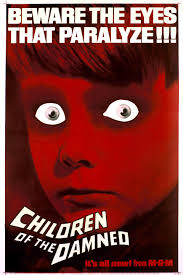Two researchers from London University, Dr. Tom Llewellyn (Ian Hendry) and Dr. David Neville (Alan Badel) are involved in children’s research for the United Nations. Tom is a psychologist, and David is a geneticist. They have been testing children all over Britain and have focused in on a young boy named Paul Looran (Clive Powell). Paul is a genius and was able to complete a complicated puzzle in minutes. He lives with his mother, Diana Looran (Sheila Allen), in a small rundown apartment.
The two men visit Diana, but she is mostly hostile to them. After they leave, Diana lashes out at Paul and tells him she hates him. Paul has psychic abilities. With his mind he hypnotizes his mother and sends her wandering into traffic where she is hit by a car. In the hospital, Diana maintains that there is no father and that she was never “touched” by man. She says that she gave birth to Paul, but he isn’t hers. She also says that he is not human. The doctors believe she is hysterical. Shortly after the accident Diana’s sister, Susan Eliot (Barbara Ferris), arrives at the apartment to take care of Paul.
Tom and David then learn that there were six children from all over the world that completed the same puzzle in the same amount of time. They also find out that all six children do not have fathers and have psychic abilities. The children are the same age and intellect. They are also in tune with each other. What one child sees and experiences, the others do as well. What is known to one is known to all of them. The other five children are Mi Ling (Yoke-Moon Lee), Nina (Roberta Rex), Rashid (Mahdu Mathen), Argo (Gerald Delsol) and Mark (Frank Summerscale). All of the children are brought to London to be retested and studied. The children quietly escape from their individual embassies and meet at an old, abandoned church. Paul uses Susan as a surrogate mother for all of them by mentally controlling her.
In the meantime, the British government decides they want to keep an eye on Paul. The other five embassies begin to realize that they also have a brilliant child with special powers and begin looking at the children as either a weapon to be used or as an enemy that should be controlled. Some officials are afraid of the children. The children are fully aware of what everyone around them thinks. When authorities try to force the children to comply, the children use their skills to kill anyone who tries to hurt them. Tom believes that the children can be reasoned with, but David wants to destroy them.
“Children of the Damned” was released in 1964 and was directed by Anton M. Leader. It is a British science fiction horror movie. It’s not exactly a sequel but more of an alternate treatment using similar themes to the first film “Village of the Damned” 1960.
The movie has its fans. Many prefer it to the first film. I liked them both. The main difference between the two is that the children in “Village” were the result of alien insemination and because of that they were evil. In “Children” they were a jump in the evolutionary ladder, or biological sport, and weren’t even sure themselves why they came about. The phenomenon of biological sport is an actual event where a sudden genetic change in something brings about a new variety of plant or a new species of animal.
Paul doesn’t speak until almost fifty-seven minutes into the film. Even then he only has a few lines in the whole movie.
There is a gay component that many people point to in the film. Tom and David are flat mates but there is no direct indication that their relationship is anything more. After all they do have separate bedrooms but some of the banter back and forth between the two scientists leads others to think they are partners. The debate rages on.


